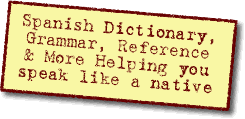Ask a Question(Create a thread) |
|
|||||||
Tú, tu, te y ti?Grammar questions– conjugations, verb tenses, adverbs, adjectives, word order, syntax, etc. |
 |
|
|
Thread Tools |
|
Get rid of these ads by registering for a free Tomísimo account.
|
|
#3
|
|||
|
|||
|
Tú = You
Tu = Your Te = I believe it is called a direct/indirect object pronoun. I can't explain it well, sorry! Ti = Used in place of tú after prepositions.
__________________
Corrijan mis errores, por favor. |
|
#4
|
|||
|
|||
|
Tú : Tú eres alto -- You are tall.
Tu: Tu coche es rápido -- Your car is fast Te: Te mandé un correo electrónico -- I sent you an email Te again: Te duelen los ojos -- Your eyes hurt (literally, the eyes hurt you) Ti/tí: Este regalo es para tí. -- This gift is for you |
|
#5
|
||||
|
||||
|
As a reminder, the prepositional pronoun ti doesn't have an accent mark. This is because there isn't another word that is pronounced the same way (a homophone doesn't exist, in other words). Its "cousin" mí has an accent mark, but the homophone mi (a determiner) doesn't have an accent mark.
|
|
#6
|
||||
|
||||
|
Quote:
Te mato - I'll kill you. |
|
#7
|
|||
|
|||
|
Quote:
And thanks for clearing that up rusty |
|
#8
|
|||
|
|||
|
Direct objects receive the action of the verb (directly) as in Te maté (I killed you [direct object]). Indirect objects tend to be the recipient of whatever receives the action of the verb as in Te mandé un email (I sent you an email). What I actually sent was the email (direct object) and I sent it to you (indirect object).
|
 |
«
Previous Thread
|
Next Thread
»
| Link to this thread | |
|
|
|||||||
All times are GMT -6. The time now is 09:53 PM.









